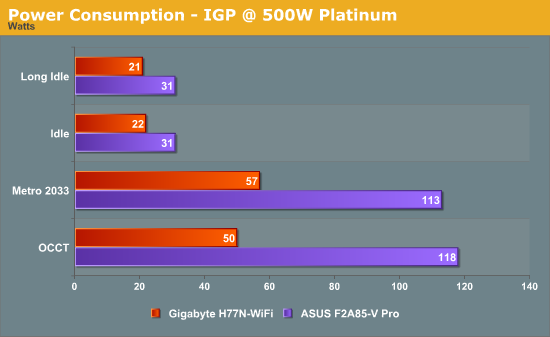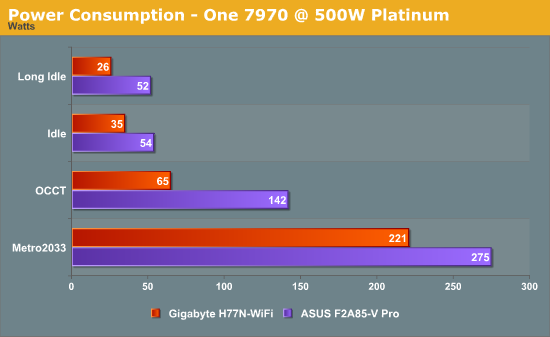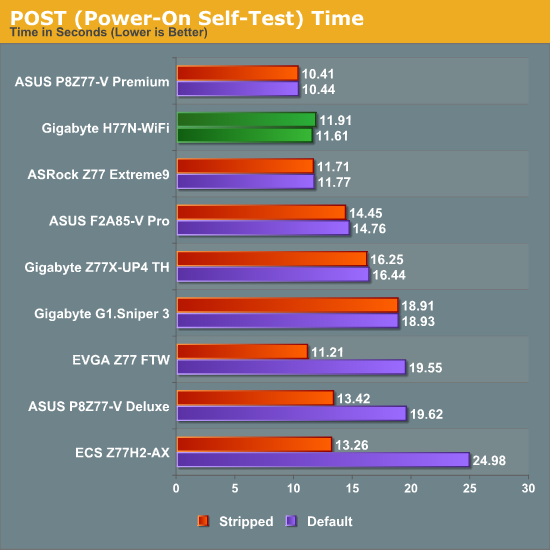Gigabyte H77N-WiFi Review – First Look at Ivy Bridge with mITX
by Ian Cutress on November 6, 2012 12:00 PM EST- Posted in
- Motherboards
- Gigabyte
- H77
- mITX
Many thanks to...
We must thank the following companies for kindly donating hardware for our test bed:
OCZ for donating the SSDs
Micron for donating our SATA testing SSD
G.Skill for donating our memory kits
ASUS for donating AMD GPUs and some IO Testing kit
ECS for donating NVIDIA GPUs
Gigabyte for donating the i3-3225 used for comparison
Rosewill for donating the Power Supply
Test Setup
| Test Bed | |
| Processor |
Intel Core i3-3225 @ 3.3 GHz 2 Cores, 4 Threads |
| Motherboards | Gigabyte H77N-WiFi |
| Cooling | Thermalright TRUE Copper |
| Power Supply | Rosewill SilentNight 500W |
| Memory | GSkill RipjawsX 2x4 GB DDR3-1600 9-9-9 |
| Memory Settings | XMP |
| Video Cards |
ASUS HD7970 3GB ECS GTX 580 1536MB |
| Video Drivers |
Catalyst 12.3 NVIDIA Drivers 296.10 WHQL |
| Hard Drive | OCZ Vertex 3 240GB |
| Optical Drive | LG GH22NS50 |
| Case | Open Test Bed - CoolerMaster Lab V1.0 |
| Operating System | Windows 7 64-bit |
| SATA Testing | OCZ Vertex 3 128GB |
| USB 2/3 Testing | OCZ Vertex 3 240GB with SATA->USB Adaptor |
Power Consumption
Power consumption was tested on the system as a whole with a wall meter connected to a Rosewill 500W 80PLUS Platinum SilentNight power supply. As I am in the UK on a 230-240 V supply, leads to ~75% efficiency at low loads, and 90%+ efficiency between 20% and 100% loading. This method of power reading allows us to compare the power management of the UEFI and the board to supply components with power under load, and includes typical PSU losses due to efficiency. These are the real world values that consumers may expect from a typical system (minus the monitor) using this motherboard.


Using the i3-3225 processor gives an amazing idle power usage – 21 W on IGP. Even with a 500W Platinum power supply, 21 W is still on the very low end of efficiency. I wouldn’t be surprised if the actual draw was more like 14-16 W.
POST Time
Different motherboards have different POST sequences before an operating system is initialized. A lot of this is dependent on the board itself, and POST boot time is determined by the controllers on board (and the sequence of how those extras are organized). As part of our testing, we are now going to look at the POST Boot Time - this is the time from pressing the ON button on the computer to when Windows starts loading. (We discount Windows loading as it is highly variable given Windows specific features.) These results are subject to human error, so please allow +/- 1 second in these results.

With the launch of Windows 8, most of the motherboard manufacturers are scrambling to update their BIOSes to take advantage of some of the Windows 8 features. This has resulted in reduced boot times – manufacturers that were taking 18 seconds to POST are down to 12 or below. I have been quoted that with the right combination of hardware and BIOS options, some setups can be in the operating system in 2-4 seconds. Nevertheless it also has a knock on affect for other operating systems – the Gigabyte H77N-WiFi is able to boot in a highly respectable 11.61 seconds with a 7970 attached.










52 Comments
View All Comments
raavan19raavan - Monday, April 15, 2013 - link
The system runs fine when the display cable is connected to IGP but when it is connected to graphics card with the above settings, the display is just black with the LED blinking and switches from ANALOG to HDMI continuously without displaying anything. Disabled the IGP too and still doesn't work. Booted the system with the IGP and tried to see if the Device Manager shows something but it only shows IGP but doesn't display anything saying that a driver is missing or any new hardware has been detected.raavan19raavan - Monday, April 15, 2013 - link
Even exchanged the graphics card assuming it was DOA but it apparently wasn't and would work fine on other system except on this motherboard.